
(a)
Interpretation:
The Lewis structure for
Concept Introduction:
Lewis structure is also known as Lewis dot diagrams or electron dot structures. The bond between atoms and lone pairs of electrons that is present in the molecule. Lewis structure represents each atom and their position in structure using the chemical symbol. Excess electrons forms the lone pair are given by pair of dots, and are located next to the atom.
(a)
Explanation of Solution
Oxygen is in Group 6A and Chlorine is in Group 7A and the valence electrons present in the

The two chlorine atoms connect with one Oxygen atom through single bonds.
Chlorine atoms attain octet by adding six electrons as dots in pairs.

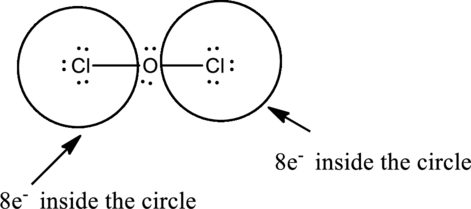
Complete the octet of the two chlorine atom uses
Put the last six electrons on Oxygen atom.
The correct Lewis structure of the

Oxygen has eight electrons four in the bonds and four as dots, hence the structure is complete.
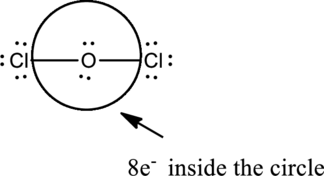
Hence, the total number of electrons can be counted as
(b)
Interpretation:
The Lewis structure for
Concept Introduction:
Refer part (a).
(b)
Explanation of Solution
Hydrogen atom is from Group one A and Oxygen atom is from group 6A, hence the valence electrons are
Complete the octet of the two chlorine atom uses
The incomplete Lewis structure of

The correct Lewis structure of the

Hence, the total number of electrons can be counted as
(c)
Interpretation:
The Lewis structure for
Concept Introduction:
Refer part (a).
(c)
Explanation of Solution
The four Hydrogen atoms connect to boron with single bonds uses eight electrons. Boron atom is the central atom with the hydrogen atoms around it. So, the valence electron present in the
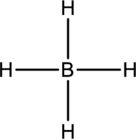
Boron atom must be the central atom with the four Hydrogen atoms bonded to it. Boron has eight electrons so, the structure is complete. Boron has eight electrons, and each Hydrogen atom has just two electrons, the structure clockwise, the total number of electrons can be counted
The correct Lewis structure of the
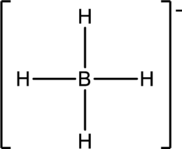
(d)
Interpretation:
The Lewis structure for
Concept Introduction:
Refer part (a).
(d)
Explanation of Solution
The four Hydrogen atoms connect to Phosphorous with single bonds uses eight electrons. Phosphorous atom is the central atom with the hydrogen atoms around it. So, the valence electrons present in the

Phosphorous atom must be the central atom with the four Hydrogen atoms bonded to it. Phosphorous has eight electrons so, the structure is complete. It has eight electrons, and each Hydrogen atom has just two electrons, the structure clockwise, the total number of electrons can be counted
The structure is a
The correct Lewis structure of the
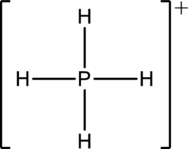
(e)
Interpretation:
The Lewis structure for
Concept Introduction:
Refer part (a).
(e)
Explanation of Solution
The five chlorine atoms connect to Phosphorous with single bonds uses ten electrons. Phosphorous atom is the central atom with the Chlorine atoms around it.
The number of valence electrons present in
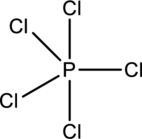
Chlorine atoms prefer making only one bond, and Phosphorous prefers to make three and five bonds. So use Phosphorous atom as central atom with the five Chlorine atoms around it.
Each Chlorine atom has three lone pair and one bond pair so it attains octet.
The correct Lewis structure of the
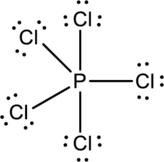
The total number of electrons can be counted as
Want to see more full solutions like this?
Chapter 6 Solutions
Chemistry: The Molecular Science
- What is the final product when D-galactose reacts with hydroxylamine?arrow_forwardIndicate the formula of the product obtained by reacting methyl 5-chloro-5-oxopentanoate with 1 mole of 4-penten-1-ylmagnesium bromide.arrow_forwardIn the two chair conformations of glucose, the most stable is the one with all the OH groups in the equatorial position. Is this correct?arrow_forward
- please help me with my homeworkarrow_forwardhelparrow_forwardThe temperature on a sample of pure X held at 1.25 atm and -54. °C is increased until the sample boils. The temperature is then held constant and the pressure is decreased by 0.42 atm. On the phase diagram below draw a path that shows this set of changes. pressure (atm) 2 0 0 200 400 temperature (K) Xarrow_forward
- QUESTION: Answer Question 5: 'Calculating standard error of regression' STEP 1 by filling in all the empty green boxes *The values are all provided in the photo attached*arrow_forwardpressure (atm) 3 The pressure on a sample of pure X held at 47. °C and 0.88 atm is increased until the sample condenses. The pressure is then held constant and the temperature is decreased by 82. °C. On the phase diagram below draw a path that shows this set of changes. 0 0 200 temperature (K) 400 аarrow_forwarder your payment details | bar xb Home | bartleby x + aleksogi/x/isl.exe/1o u-lgNskr7j8P3jH-1Qs_pBanHhviTCeeBZbufuBYT0Hz7m7D3ZcW81NC1d8Kzb4srFik1OUFhKMUXzhGpw7k1 O States of Matter Sketching a described thermodynamic change on a phase diagram 0/5 The pressure on a sample of pure X held at 47. °C and 0.88 atm is increased until the sample condenses. The pressure is then held constant and the temperature is decreased by 82. °C. On the phase diagram below draw a path that shows this set of changes. pressure (atm) 1 3- 0- 0 200 Explanation Check temperature (K) 400 X Q Search L G 2025 McGraw Hill LLC. All Rights Reserved Terms of Use Privacy Cearrow_forward
 Chemistry: The Molecular ScienceChemistryISBN:9781285199047Author:John W. Moore, Conrad L. StanitskiPublisher:Cengage Learning
Chemistry: The Molecular ScienceChemistryISBN:9781285199047Author:John W. Moore, Conrad L. StanitskiPublisher:Cengage Learning
